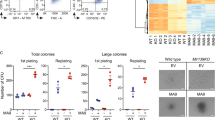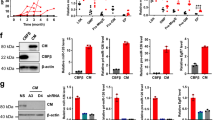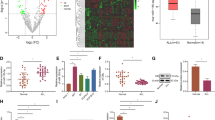Abstract
MicroRNAs (miRNAs) play a pivotal role in the regulation of hematopoiesis and development of leukemia. Great interest emerged in modulating miRNA expression for therapeutic purposes. In order to identify miRNAs, which specifically suppress leukemic growth of acute myeloid leukemia (AML) with t(8;21), inv(16) or mixed lineage leukemia (MLL) rearrangement by inducing differentiation, we conducted a miRNA expression profiling in a cohort of 90 cytogenetically characterized, de novo pediatric AML cases. Four miRNAs, specifically downregulated in MLL-rearranged, t(8;21) or inv(16) AMLs, were characterized by their tumor-suppressive properties in cell lines representing those respective cytogenetic groups. Among those, forced expression of miR-9 reduced leukemic growth and induced monocytic differentiation of t(8;21) AML cell lines in vitro and in vivo. The tumor-suppressive functions of miR-9 were specifically restricted to AML cell lines and primary leukemic blasts with t(8;21). On the other hand, these functions were not evident in AML blasts from patients with MLL rearrangements. We showed that miR-9 exerts its effects through the cooperation with let-7 to repress the oncogenic LIN28B/HMGA2 axis. Thus, miR-9 is a tumor suppressor-miR which acts in a stringent cell context-dependent manner.
This is a preview of subscription content, access via your institution
Access options
Subscribe to this journal
Receive 12 print issues and online access
$259.00 per year
only $21.58 per issue
Buy this article
- Purchase on Springer Link
- Instant access to full article PDF
Prices may be subject to local taxes which are calculated during checkout





Similar content being viewed by others
Accession codes
References
Creutzig U, van den Heuvel-Eibrink MM, Gibson B, Dworzak MN, Adachi S, de Bont E et al. Diagnosis and management of acute myeloid leukemia in children and adolescents: recommendations from an international expert panel. Blood 2012; 120: 3187–3205.
Balgobind BV, Hollink IHIM, Arentsen-Peters STCJM, Zimmermann M, Harbott J, Beverloo B et al. Integrative analysis of type-I and type-II aberrations underscores the genetic heterogeneity of pediatric acute myeloid leukemia. Haematologica 2011; 96: 1478–1487.
Döhner H, Estey EH, Amadori S, Appelbaum FR, Büchner T, Burnett AK et al. Diagnosis and management of acute myeloid leukemia in adults: recommendations from an international expert panel, on behalf of the European LeukemiaNet. Blood 2010; 115: 453–474.
Zhang L, Sankaran VG, Lodish HF . MicroRNAs in erythroid and megakaryocytic differentiation and megakaryocyte-erythroid progenitor lineage commitment. Leukemia 2012; 26: 2310–2316.
Bartel DP, Chen C-Z . Micromanagers of gene expression: the potentially widespread influence of metazoan microRNAs. Nat Rev Genet 2004; 5: 396–400.
Volinia S, Galasso M, Costinean S, Tagliavini L, Gamberoni G, Drusco A et al. Reprogramming of miRNA networks in cancer and leukemia. Genome Res 2010; 20: 589–599.
Jongen-Lavrencic M, Sun SM, Dijkstra MK, Valk PJM, Lowenberg B, Löwenberg B . MicroRNA expression profiling in relation to the genetic heterogeneity of acute myeloid leukemia. Blood 2008; 111: 5078–5085.
Maki K, Yamagata T, Sugita F, Nakamura Y, Sasaki K, Mitani K . Aberrant expression of MIR9 indicates poor prognosis in acute myeloid leukaemia. Br J Haematol 2012; 158: 283–285.
Sun SM, Rockova V, Bullinger L, Dijkstra MK, Döhner H, Löwenberg B et al. The prognostic relevance of miR-212 expression with survival in cytogenetically and molecularly heterogeneous AML. Leukemia 2013; 27: 100–106.
Schwind S, Maharry K, Radmacher MD, Mrózek K, Holland KB, Margeson D et al. Prognostic significance of expression of a single microRNA, miR-181a, in cytogenetically normal acute myeloid leukemia: a Cancer and Leukemia Group B study. J Clin Oncol 2010; 28: 5257–5264.
Oorschot AAD, Kuipers JE, Arentsen-peters S, Schotte D, Reinhardt D, De Haas V et al. Differentially expressed miRNAs in cytogenetic and molecular subtypes of pediatric acute myeloid leukemia. Pediatr Blood Cancer 2011; 2: 1–7.
Popovic R, Riesbeck LE, Velu CS, Chaubey A, Zhang J, Achille NJ et al. Regulation of mir-196b by MLL and its overexpression by MLL fusions contributes to immortalization. Blood 2009; 113: 3314–3322.
Batliner J, Buehrer E, Federzoni EA, Jenal M, Tobler A, Torbett BE et al. Transcriptional regulation of MIR29B by PU.1 (SPI1) and MYC during neutrophil differentiation of acute promyelocytic leukaemia cells. Br J Haematol 2012; 157: 270–274.
Klusmann JH, Li Z, Böhmer K, Maroz A, Koch ML, Emmrich S et al. miR-125b-2 is a potential oncomiR on human chromosome 21 in megakaryoblastic leukemia. Genes Dev 2010; 24: 478–490.
Mims A, Walker AR, Huang X, Sun J, Wang H, Santhanam R et al. Increased anti-leukemic activity of decitabine via AR-42-induced upregulation of miR-29b: a novel epigenetic-targeting approach in acute myeloid leukemia. Leukemia 2013; 27: 871–878.
Bai H, Cao Z, Deng C, Zhou L, Wang C . miR-181a sensitizes resistant leukaemia HL-60/Ara-C cells to Ara-C by inducing apoptosis. J Cancer Res Clin Oncol 2012; 138: 595–602.
Kaspers GJ, Veerman AJ, Pieters R, Broekema GJ, Huismans DR, Kazemier KM et al. Mononuclear cells contaminating acute lymphoblastic leukaemic samples tested for cellular drug resistance using the methyl-thiazol-tetrazolium assay. Br J Cancer 1994; 70: 1047–1052.
Stankov MV, El Khatib M, Kumar Thakur B, Heitmann K, Panayotova-Dimitrova D, Schoening J et al. Histone deacetylase inhibitors induce apoptosis in myeloid leukemia by suppressing autophagy. Leukemia 2014; 28: 577–588.
Van Vlierberghe P, van Grotel M, Beverloo HB, Lee C, Helgason T, Buijs-Gladdines J et al. The cryptic chromosomal deletion del(11)(p12p13) as a new activation mechanism of LMO2 in pediatric T-cell acute lymphoblastic leukemia. Blood 2006; 108: 3520–3529.
Emmrich S, Henke K, Hegermann J, Ochs M, Reinhardt D, Klusmann JH . miRNAs can increase the efficiency of ex vivo platelet generation. Ann Hematol 2012; 91: 1673–1684.
Loya CM, Lu CS, Van Vactor D, Fulga TA . Transgenic microRNA inhibition with spatiotemporal specificity in intact organisms. Nat Methods 2009; 6: 897–903.
Maetzig T, Galla M, Brugman MH, Loew R, Baum C, Schambach A . Mechanisms controlling titer and expression of bidirectional lentiviral and gammaretroviral vectors. Gene Ther 2010; 17: 400–411.
Klusmann JH, Godinho FJ, Heitmann K, Maroz A, Koch ML, Reinhardt D et al. Developmental stage-specific interplay of GATA1 and IGF signaling in fetal megakaryopoiesis and leukemogenesis. Genes Dev 2010; 24: 1659–1672.
R Development Core Team. R: A Language and Environment for Statistical Computing. R Foundation for Statistical Computing: Vienna, Austria, 2011.
Smyth GK . Linear models and emperical Bayes methods for assessing differential expression in microarray experiments. Stat Appl Genet Mol Biol 2004; 3: 1–25.
Xiao F, Zuo Z, Cai G, Kang S, Gao X, Li T . miRecords: an integrated resource for microRNA-target interactions. Nucleic Acids Res 2009; 37: D105–D110.
Wang X . miRDB: A microRNA target prediction and functional annotation database with a wiki interface. RNA 2008; 14: 1012–1017.
Kertesz M, Iovino N, Unnerstall U, Gaul U, Segal E . The role of site accessibility in microRNA target recognition. Nat Genet 2007; 39: 1278–1284.
Lewis BP, Burge CB, Bartel DP . Conserved seed pairing, often flanked by adenosines, indicates that thousands of human genes are microRNA targets. Cell 2005; 120: 15–20.
Li Z, Huang H, Li Y, Jiang X, Chen P, Arnovitz S et al. Up-regulation of a HOXA-PBX3 homeobox-gene signature following down-regulation of miR-181 is associated with adverse prognosis in patients with cytogenetically abnormal AML. Blood 2012; 119: 2314–2324.
Petriv OI, Kuchenbauer F, Delaney AD, Lecault V, White A, Kent D et al. Comprehensive microRNA expression profiling of the hematopoietic hierarchy. PNAS 2010; 107: 15443–15448.
Hegde SP, Zhao J, Ashmun RA, Shapiro LH . c-Maf induces monocytic differentiation and apoptosis in bipotent myeloid progenitors. Blood 1999; 94: 1578–1589.
Aziz A, Soucie E, Sarrazin S, Sieweke MH . MafB/c-Maf deficiency enables self-renewal of differentiated functional macrophages. Science 2009; 326: 867–871.
Yuan J, Nguyen CK, Liu X, Kanellopoulou C, Muljo SA . Lin28b reprograms adult bone marrow hematopoietic progenitors to mediate fetal-like lymphopoiesis. Science 2012; 335: 1195–1200.
Odero MD, Grand FH, Iqbal S, Ross F, Roman JP, Vizmanos JL et al. Disruption and aberrant expression of HMGA2 as a consequence of diverse chromosomal translocations in myeloid malignancies. Leukemia 2005; 19: 245–252.
Piskounova E, Polytarchou C, Thornton JE, Hagan JP, Lapierre J, Pothoulakis C et al. Oncogenic Lin28A and Lin28B inhibit let-7 microRNA biogenesis by distinct mechanisms. Cell 2012; 147: 730–748.
Johnson SM, Grosshans H, Shingara J, Byrom M, Jarvis R, Cheng A et al. RAS is regulated by the let-7 microRNA family. Cell 2005; 120: 635–647.
Lee YS, Dutta A . The tumor suppressor microRNA let-7 represses the HMGA2 oncogene. Genes Dev 2007; 21: 1025–1030.
Senyuk V, Zhang Y, Liu Y, Ming M, Premanand K, Zhou L et al. Critical role of miR-9 in myelopoiesis and EVI1-induced leukemogenesis. P Natl Acad Sci USA 2013; 110: 5594–5599.
Lin X, Rice KL, Buzzai M, Hexner E, Costa FF, Kilpivaara O et al. miR-433 is aberrantly expressed in myeloproliferative neoplasms and suppresses hematopoietic cell growth and differentiation. Leukemia 2013; 27: 344–352.
Forrest ARR, Kanamori-Katayama M, Tomaru Y, Lassmann T, Ninomiya N, Takahashi Y et al. Induction of microRNAs, mir-155, mir-222, mir-424 and mir-503, promotes monocytic differentiation through combinatorial regulation. Leukemia 2010; 24: 460–466.
Mann G, Reinhardt D, Ritter J, Hermann J, Schmitt K, Gadner H et al. Treatment with all-trans retinoic acid in acute promyelocytic leukemia reduces early deaths in children. Ann Hematol 2001; 80: 417–422.
Chen P, Price C, Li Z, Li Y, Cao D, Wiley A et al. miR-9 is an essential oncogenic microRNA specifically overexpressed in mixed lineage leukemia-rearranged leukemia. P Natl Acad Sci USA 2013; 110: 11511–11516.
Yu J, Vodyanik MA, Smuga-Otto K, Antosiewicz-Bourget J, Frane JL, Tian S et al. Induced pluripotent stem cell lines derived from human somatic cells. Science 2007; 318: 1917–1920.
Heo I, Joo C, Cho J, Ha M, Han J, Kim VN . Lin28 mediates the terminal uridylation of let-7 precursor MicroRNA. Mol Cell 2008; 32: 276–284.
Viswanathan SR, Daley GQ, Gregory RI . Selective blockade of microRNA processing by Lin-28. Science 2008; 320: 97–100.
Rybak A, Fuchs H, Smirnova L, Brandt C, Pohl EE, Nitsch R et al. A feedback loop comprising lin-28 and let-7 controls pre-let-7 maturation during neural stem-cell commitment. Nat Cell Biol 2008; 10: 987–993.
Newman MA, Thomson JM, Hammond SM . Lin-28 interaction with the Let-7 precursor loop mediates regulated microRNA processing. RNA 2008; 14: 1539–1549.
Büssing I, Slack FJ, Grosshans H . let-7 microRNAs in development, stem cells and cancer. Trends Mol Med 2008; 14: 400–409.
Tessari M, Gostissa M, Altamura S, Sgarra R, Rusthigh A, Salvagno C et al. Transcriptional activation of the cyclin A gene by the architectural transcription factor HMGA2. Mol Cell Biol 2003; 23: 9104–9116.
Fedele M, Battista S, Kenyon L . Overexpression of the HMGA2 gene in transgenic mice leads to the onset of pituitary adenomas. Oncogene 2002; 21: 3190–3198.
Schoenmakers E, Wanschura S, Mols R, Bullerdiek J, Berghe H Van den, Ven WJM Van de . Recurrent rearrangements in the high mobility group protein gene, HMGI-C, in benign mesenchymal tumours. Nature 1995; 10: 436–444.
Mayr C, Hemann M, Bartel D . Disrupting the pairing between let-7 and Hmga2 enhances oncogenic transformation. Science 2007; 315: 1576–1579.
Acknowledgements
The authors would like to thank J Schoening for general lab support; Drs. K Weber and B Fehse for providing plasmids. SE, FE, RJ and KH were supported by the Hannover Biomedical Research School. JEK-K, LV and AAD-vO were supported by the Children Cancer Free Foundation (KIKA, project 49). JHK is a fellow of the Emmy Noether-Programme from the German Research Foundation (DFG; KL-2374/2-1). This work was supported by grants to JHK from the DFG (KL-2374/2-1) and to JEK, CMZ and MMvdH-E from KIKA (project 49).
Author contributions
SE, KH, FE, RJ, FD, and MEK performed all in vitro and in vivo experiments and analyzed data. JEK-K, LV, AAD-vO. performed expression studies and analyzed data. SE designed experiments and wrote the manuscript. KH and JEK-K wrote the manuscript. MEK revised the manuscript. JHK designed and supervised the study, analyzed data and wrote the paper. MMvdH-E designed and supervised the study and wrote the manuscript. DR, JS, AB and VdH contributed materials and clinical data and revised the manuscript. DR, CMZ, MLdB, MF and RP supervised the study and revised the manuscript.
Author information
Authors and Affiliations
Corresponding authors
Ethics declarations
Competing interests
The authors declare no conflict of interest.
Additional information
Supplementary Information accompanies this paper on the Leukemia website
Rights and permissions
About this article
Cite this article
Emmrich, S., Katsman-Kuipers, J., Henke, K. et al. miR-9 is a tumor suppressor in pediatric AML with t(8;21). Leukemia 28, 1022–1032 (2014). https://doi.org/10.1038/leu.2013.357
Received:
Revised:
Accepted:
Published:
Issue Date:
DOI: https://doi.org/10.1038/leu.2013.357
Keywords
This article is cited by
-
Epigenetic regulation in hematopoiesis and its implications in the targeted therapy of hematologic malignancies
Signal Transduction and Targeted Therapy (2023)
-
Tumor-suppressing effects of miR-381-3p in pediatric acute myeloid leukemia via ROCK1 downregulation
Functional & Integrative Genomics (2023)
-
Role of non-coding RNA networks in leukemia progression, metastasis and drug resistance
Molecular Cancer (2020)
-
Myeloid leukemia with high EVI1 expression is sensitive to 5-aza-2′-deoxycytidine by targeting miR-9
Clinical and Translational Oncology (2020)
-
MicroRNAs: pivotal regulators in acute myeloid leukemia
Annals of Hematology (2020)



